Stinkweed is a common name for several noxiously scented plants, and may refer to:
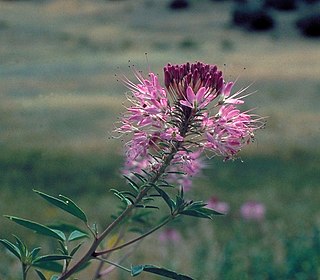
Cleomella serrulata, commonly known as Rocky Mountain beeplant/beeweed, stinking-clover, bee spider-flower, skunk weed, Navajo spinach, and guaco, is a species of annual plant in the genus Cleomella. Many species of insects are attracted to it, especially bees, which helps in the pollination of nearby plants. It is native to southern Canada and the western and central United States. The plant has often been used for food, to make dyes for paint, and as a treatment in traditional medicine.

The Capparaceae, commonly known as the caper family, are a family of plants in the order Brassicales. As currently circumscribed, the family contains 15 genera and about 430 species. The largest genera are Capparis, Morisonia, Maerua, Boscia, and Cadaba.

The Cleomaceae are a small family of flowering plants in the order Brassicales, comprising about 220 species in two genera, Cleome and Cleomella. These genera were previously included in the family Capparaceae, but were raised to a distinct family when DNA evidence suggested the genera included in it are more closely related to the Brassicaceae than they are to the Capparaceae. The APG II system allows for Cleomaceae to be included in Brassicaceae. Cleomaceae includes C3, C3–C4, and C4 photosynthesis species.

Cleomella refracta, common names jackass clover or spectacle fruit, is a species of flowering plant in the cleome family, Cleomaceae. It is native to northwestern Mexico and the southwestern United States, particularly Chihuahua, Sonora, trans-Pecos Texas, New Mexico, Arizona, Utah, Nevada and California. The species occurs in sandy flats, desert scrub and disturbed sites such as roadsides.
Cleomella sparsifolia is a species of flowering plant known by the common names fewleaf cleome and fewleaf spiderflower. This annual wildflower is native to California and Nevada where it grows in desert sand. This is an erect, branching plant not exceeding a meter in height. Its sparse leaves are each made up of 3 thick, oval-shaped leaflets. The bright yellow flowers have curving petals and long stamens tipped with knobby anthers. The fruit is a capsule up to 4 centimeters long.

Hypericum canariense is a species of flowering plant in the family Hypericaceae known by the common name Canary Islands St. John's wort. It is the sole member of Hypericumsect. Webbia.
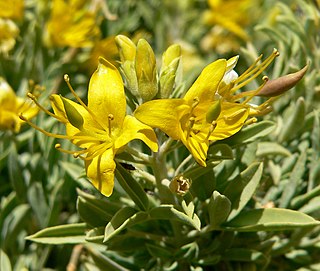
Cleomella arborea, is a perennial shrub or bush in the spiderflower family (Cleomaceae) known by the common names bladderpod, bladderpod spiderflower and burro-fat. It has yellow flowers in bloom all months of the year. It emits a foul odor to discourage herbivory from insects.

Cleomella platycarpa is a species of flowering plant in the cleome family known by the common names golden bee plant and golden spiderflower. It is native to the western United States from northeastern California to Idaho, including the Modoc Plateau, where it grows on clay and volcanic soils in the sagebrush. It is an annual herb branching at the base into several erect stems up to about 60 centimetres (24 in) tall. The stems are green tinted with purple, coated densely in glandular hairs, and lined with many leaves. Each leaf is divided into three small leaflets. The top of each stem is occupied by a raceme of many flowers. Each flower has generally four yellow sepals and four yellow petals around a center of many yellow stamens. The fruit is a flat, hairy capsule up to 2.5 centimeters long which hangs on the long, remaining flower receptacle. Found between 800–1200m.
Cleomella brevipes is a species of flowering plant in the cleome family known by the common name shortstalk stinkweed. It is native to the Mojave Desert and adjacent hills, where it grows in wet alkaline environments such as mineral-rich desert hot springs. It is an annual herb producing a rough, waxy, red stem up to about 45 centimeters tall. The stem is lined with many small fleshy leaves, each divided into three leaflets. Flowers appear in the leaf axils all along the stem, often all the way down to the base. Each grows at the end of a short, erect pedicel. The flower has four tiny yellow sepals and four tiny yellow petals. The fruit is a somewhat rounded, hanging capsule developing at the end of the remaining flower receptacle.
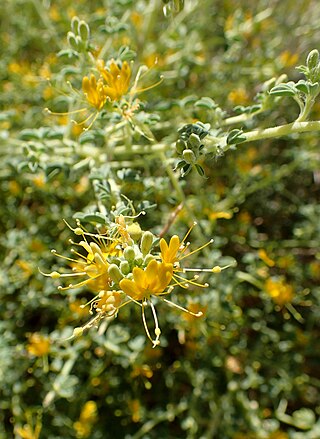
Cleomella obtusifolia is a species of flowering plant in the cleome family. It is commonly known as Mojave stinkweed, bluntleaf stinkweed or Mojave Cleomella. It grows in alkaline soils in the desert scrub. It is an annual herb producing a rough, hairy stem. The branching stem grows erect when new and then the branches droop to the ground with age, forming a bushy clump or mat. Each leaf is made up of three fleshy oval leaflets. Flowers appear in dense racemes on older stems and solitary in leaf axils on new stems. Each flower has generally four hairy green sepals and four yellow petals grouped together on one side of the involucre. The whiskery yellow stamens protrude up to 1.5 centimeters from the flower. The fruit is a hairy, valved capsule a few millimeters in length. It hangs at the tip of the remaining flower receptacle.
Cleomella parviflora is a species of flowering plant in the cleome family known by the common name slender stinkweed. It is native to eastern California and western Nevada, where it grows in desert and sagebrush scrub in the Mojave Desert and southern parts of the Great Basin. It is an annual herb producing a smooth, hairless, reddish stem up to about 45 centimeters tall. There are a few leaves, each made up of three elongated, fleshy leaflets. Most of the flowers are located in a raceme at the tips of the stem branches, and there may be a few solitary flowers in the axils of the leaves. Each flower has four tiny pale yellow petals, each about 2 millimeters long. The fruit is a lobed, valved capsule which hangs on the tip of the remaining flower receptacle.
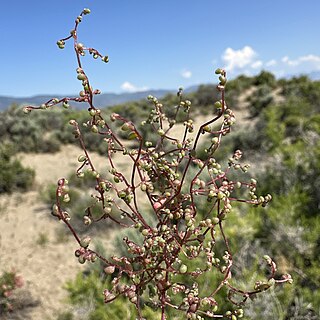
Micromonolepis pusilla, is the only species of the genus Micromonolepis in the flowering plant family Amaranthaceae, known by the common names small povertyweed and red povertyweed. It is native to the Western United States, including the Great Basin and surrounding areas, where it grows in sandy scrub, dry valleys, playas, and other open habitat. It is a somewhat fleshy annual herb producing a branching, slender stem that has a mealy whitish texture when young and turns dull to bright red with age, losing its grainy coat. It grows up to 14 to 20 centimeters tall. The thick oblong leaves are up to a centimeter long. Clusters of 1 to 3 minute flowers appear in the leaf axils, each flower made up of 3 tiny sepals.

Cleomella oxystyloides is a species of flowering plants in the cleome family, Cleomaceae, which is known by the common name spiny caper. It is native to the Mojave Desert straddling the border between California and Nevada. It grows in rocky and sandy desert habitat, often on alkaline soils. This is an annual herb producing an erect, branching stem which may reach 1.5 meters in height. The leaf is made up of three thick, firm leaflets 2 to 6 centimeters long, borne on a stout, straight petiole. The inflorescence is a dense head of flowers clustered about the stem at the leaf axils, each flower with four small yellow petals. The fruit is a small white or purple nutlet bearing the spine-like remnant of the flower receptacle.

Godyris is a genus of clearwing (ithomiine) butterflies, named by Jean Baptiste Boisduval in 1870. They are in the brush-footed butterfly family, Nymphalidae.

Godyris zavaleta, the Zavaleta glasswing, is a species of butterfly of the family Nymphalidae. It is found from Costa Rica to southern Peru. The habitat consists of lowland and mid-elevation rainforests at altitudes up to 900 meters.
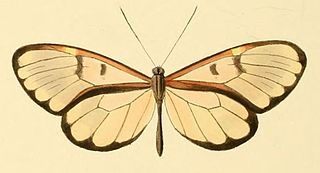
Godyris crinippa is a species of butterfly of the family Nymphalidae. It is found in Bolivia and Peru.
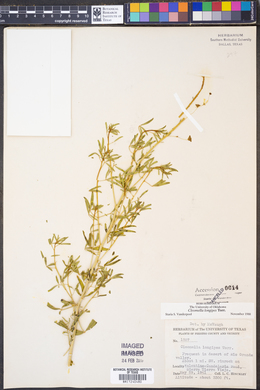
Cleomella longipes, the Chiricahua Mountain stinkweed, is a plant species native to northern Mexico and to the southwestern United States. It has been reported from Chihuahua, San Luis Potosí, trans-Pecos Texas, New Mexico Arizona. It is found on saline or alkaline flats at elevations of 500–1000 m.

Cleomella angustifolia, the narrowleaf rhombopod, is a plant species native to the south-central United States. It grows in roadsides, grasslands, stream banks, and pond shores in Texas, Oklahoma, Kansas, Nebraska and Colorado.














